Abstract
Maximising the rate of drug delivered in particles small enough to reach the lower respiratory tract from jet nebulisers may allow treatment times to be reduced and thus improve the acceptability of this form of treatment, particularly in very young patients. The role of various technical factors such as driving gas flow (DGF) in determining the rate of drug delivery was studied by constructing a model to simulate the respiratory pattern of individuals with different tidal volumes using a Starling ventilator and filter. Sodium cromoglycate was nebulised under a variety of operating conditions and the dose deposited on the filter was assayed. Tidal volumes of 50 and 400 ml were used at a frequency of 32 breaths per minute. Increasing the DGF from 4 to 8 l/minute produced a 264% increase in the rate of drug output but only a 32% increase in aerosol concentration. The mass of drug contained within droplets less than 5 microns increased from 26.8% to 70.8% of the total. The resultant increase in rate of drug delivery to the filter was 34% for a tidal volume of 50 ml and 79% for a tidal volume of 400 ml though the dose contained within droplets less than 5 microns increased by 4-fold at 50 ml tidal volume and by more than 5-fold at the higher tidal volume. Halving the solution concentration halved the rate of drug delivery. Increasing the tidal volume 8-fold from 50 to 400 ml resulted in an increase in the rate of drug deposition upon the filter of only 2.2 to 3-fold depending upon the DGF so that substantially more drug per ml inhaled was delivered at the lower tidal volume. These results are explained by considering factors that influence the rate of drug delivery. At low tidal volumes the rate of drug delivery at a given respiratory rate is dependent on the tidal volume and aerosol concentration. At high tidal volumes it is dependent upon aerosol concentration and volume of available aerosol and is essentially independent of tidal volume.
Full text
PDF
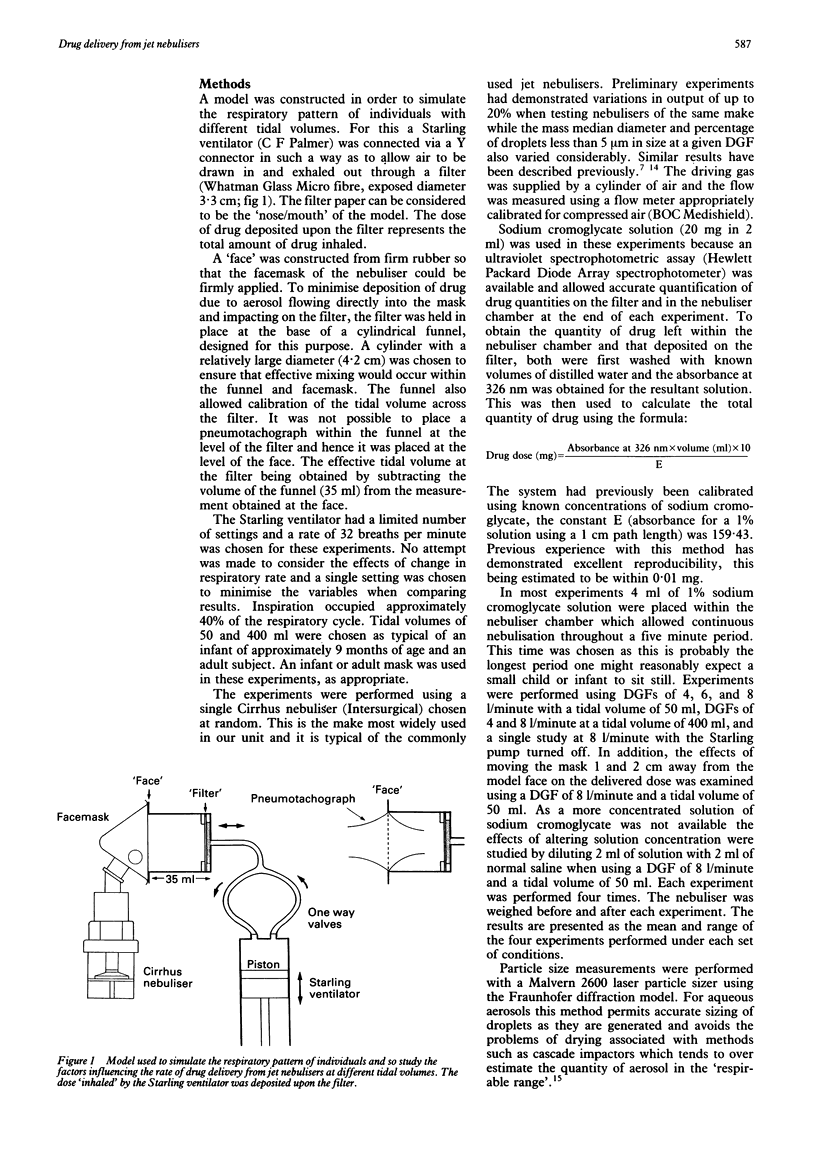
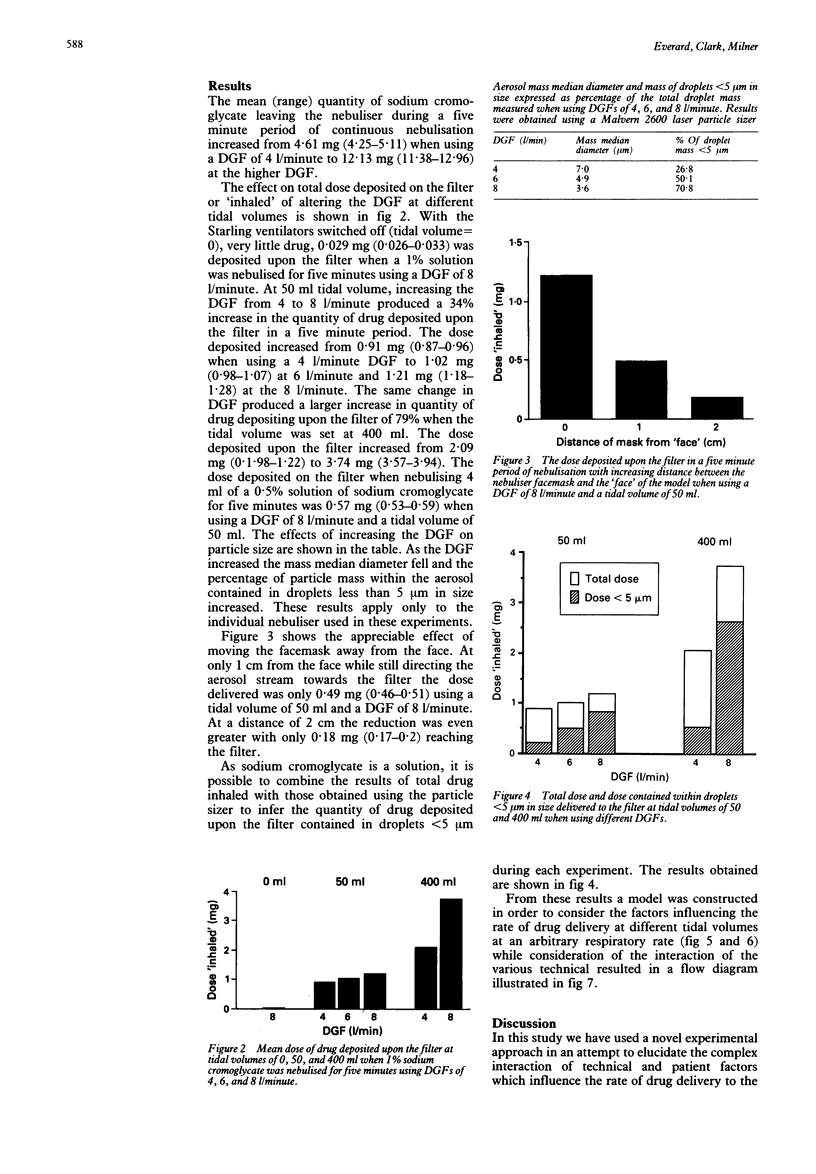
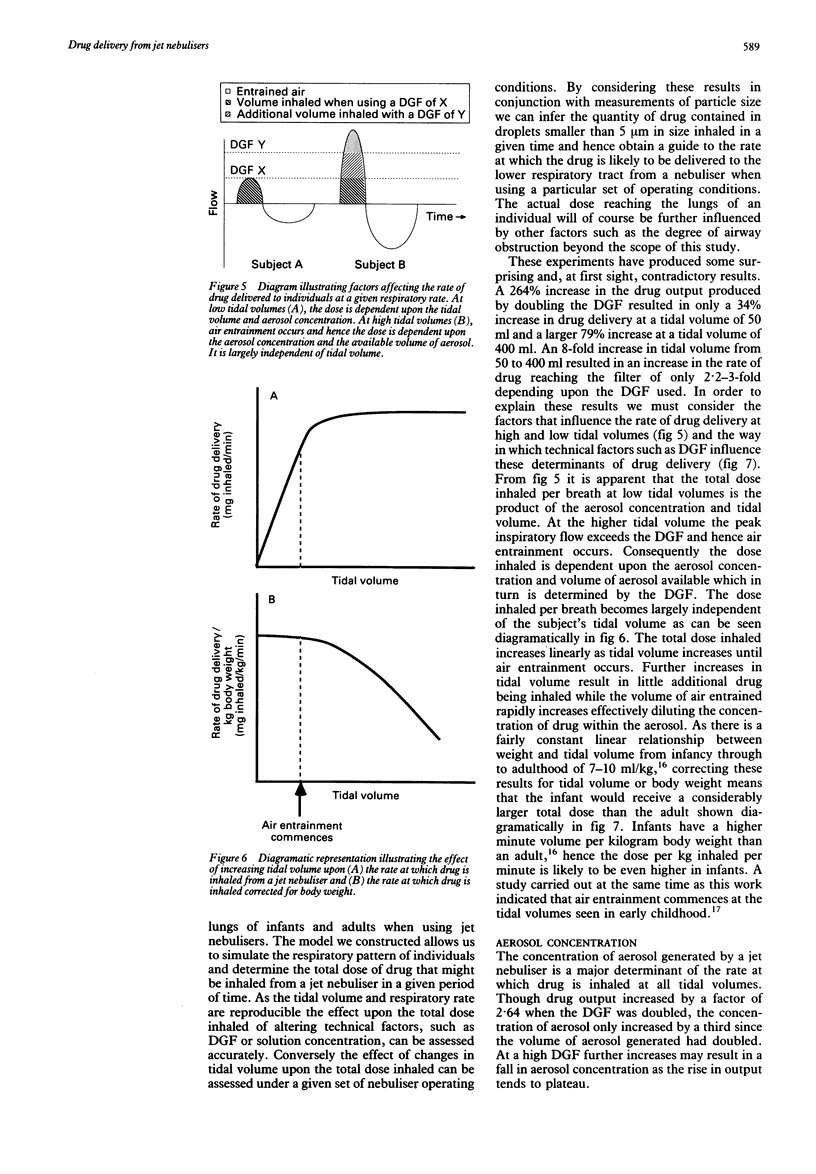
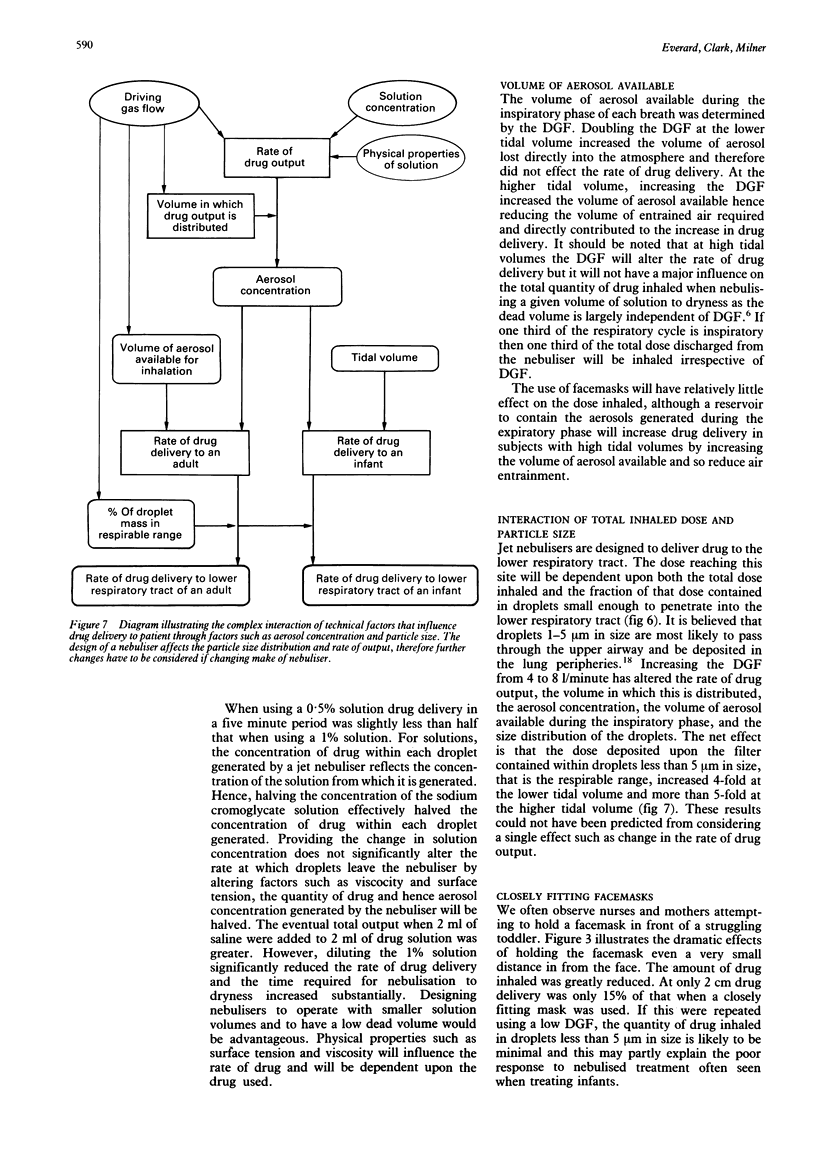
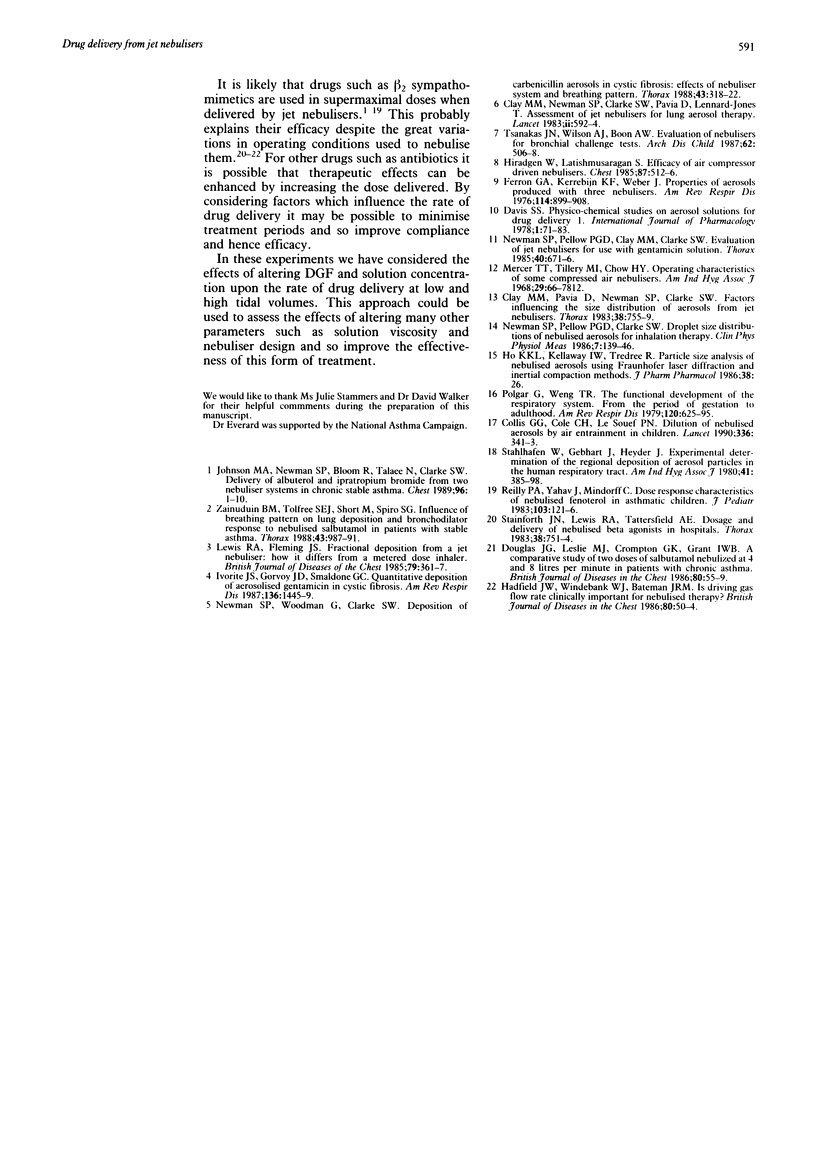
Selected References
These references are in PubMed. This may not be the complete list of references from this article.
- Clay M. M., Pavia D., Newman S. P., Clarke S. W. Factors influencing the size distribution of aerosols from jet nebulisers. Thorax. 1983 Oct;38(10):755–759. doi: 10.1136/thx.38.10.755. [DOI] [PMC free article] [PubMed] [Google Scholar]
- Clay M. M., Pavia D., Newman S. P., Lennard-Jones T., Clarke S. W. Assessment of jet nebulisers for lung aerosol therapy. Lancet. 1983 Sep 10;2(8350):592–594. doi: 10.1016/s0140-6736(83)90679-7. [DOI] [PubMed] [Google Scholar]
- Collis G. G., Cole C. H., Le Souëf P. N. Dilution of nebulised aerosols by air entrainment in children. Lancet. 1990 Aug 11;336(8711):341–343. doi: 10.1016/0140-6736(90)91880-j. [DOI] [PubMed] [Google Scholar]
- Ferron G. A., Kerrebijn K. F., Weber J. Properties of aerosols produced with three nebulizers. Am Rev Respir Dis. 1976 Nov;114(5):899–908. doi: 10.1164/arrd.1976.114.5.899. [DOI] [PubMed] [Google Scholar]
- Ilowite J. S., Gorvoy J. D., Smaldone G. C. Quantitative deposition of aerosolized gentamicin in cystic fibrosis. Am Rev Respir Dis. 1987 Dec;136(6):1445–1449. doi: 10.1164/ajrccm/136.6.1445. [DOI] [PubMed] [Google Scholar]
- Johnson M. A., Newman S. P., Bloom R., Talaee N., Clarke S. W. Delivery of albuterol and ipratropium bromide from two nebulizer systems in chronic stable asthma. Efficacy and pulmonary deposition. Chest. 1989 Jul;96(1):6–10. doi: 10.1378/chest.96.1.6. [DOI] [PubMed] [Google Scholar]
- Kradjan W. A., Lakshminarayan S. Efficiency of air compressor-driven nebulizers. Chest. 1985 Apr;87(4):512–516. doi: 10.1378/chest.87.4.512. [DOI] [PubMed] [Google Scholar]
- Lewis R. A., Fleming J. S. Fractional deposition from a jet nebulizer: how it differs from a metered dose inhaler. Br J Dis Chest. 1985 Oct;79(4):361–367. doi: 10.1016/0007-0971(85)90069-5. [DOI] [PubMed] [Google Scholar]
- Newman S. P., Pellow P. G., Clarke S. W. Droplet size distributions of nebulised aerosols for inhalation therapy. Clin Phys Physiol Meas. 1986 May;7(2):139–146. doi: 10.1088/0143-0815/7/2/004. [DOI] [PubMed] [Google Scholar]
- Polgar G., Weng T. R. The functional development of the respiratory system from the period of gestation to adulthood. Am Rev Respir Dis. 1979 Sep;120(3):625–695. doi: 10.1164/arrd.1979.120.3.625. [DOI] [PubMed] [Google Scholar]
- Reilly P. A., Yahav J., Mindorff C., Kazim F., Levison H. Dose-response characteristics of nebulized fenoterol in asthmatic children. J Pediatr. 1983 Jul;103(1):121–126. doi: 10.1016/s0022-3476(83)80797-5. [DOI] [PubMed] [Google Scholar]
- Stahlhofen W., Gebhart J., Heyder J. Experimental determination of the regional deposition of aerosol particles in the human respiratory tract. Am Ind Hyg Assoc J. 1980 Jun;41(6):385–98a. doi: 10.1080/15298668091424933. [DOI] [PubMed] [Google Scholar]
- Tsanakas J. N., Wilson A. J., Boon A. W. Evaluation of nebulisers for bronchial challenge tests. Arch Dis Child. 1987 May;62(5):506–508. doi: 10.1136/adc.62.5.506. [DOI] [PMC free article] [PubMed] [Google Scholar]
- Zainudin B. M., Tolfree S. E., Short M., Spiro S. G. Influence of breathing pattern on lung deposition and bronchodilator response to nebulised salbutamol in patients with stable asthma. Thorax. 1988 Dec;43(12):987–991. doi: 10.1136/thx.43.12.987. [DOI] [PMC free article] [PubMed] [Google Scholar]


